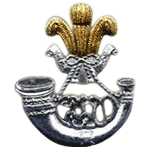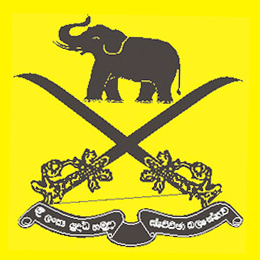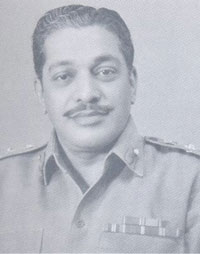Related Research Articles
The Ceylon Defence Force (CDF) was established in 1910 by the Ceylonese legislation Ceylon Defence Force Ordinance, which reformed the Ceylon Volunteer Force (CVF) that existed previously as the military reserve in the British Crown colony of Ceylon. At the time of forming it was only a reserve force but soon developed into a regular force responsible for the defence of Ceylon. The CDF was under the command of the General Officer Commanding, Ceylon of the British Army in Ceylon if mobilised. However mobilisation could be carried out only under orders from the Governor.

Lieutenant General Denzil Lakshman Kobbekaduwa, RWP, RSP, VSV, USP was a senior Sri Lankan Army officer who served in the 1971 Insurrection and the Sri Lankan Civil War.

The Sri Lanka Army is the oldest and largest of the Sri Lanka Armed Forces. Established as the Ceylon Army in 1949, it was renamed when Sri Lanka became a republic in 1972. In 2010, the Army had approximately 200,000 regular personnel, between 20,000 and 40,000 reserve (volunteer) personnel and 18,000 National Guardsmen and comprises 13 divisions, one air-mobile brigade, one commando brigade, one special forces brigade, one independent armored brigade, three mechanized infantry brigades and over 40 infantry brigades.

The Sri Lanka Light Infantry (SLLI) is the oldest regiment in the Sri Lanka Army and the oldest infantry regiment in the army. It is made up of ten regular battalions and five volunteer battalions, and is headquartered at the Panagoda Cantonment, Panagoda. Over the years it has become the most distinguished and dependable regiment in the army.
The National Cadet Corps (NCC) is a youth organisation in Sri Lanka, sponsored by the Ministry of Defence, which operates in schools, and normally includes Army, Navy and Air Force sections. The corp is open for secondary school students on voluntary basis and its officers are government teachers and educational administrators, who serve as instructors. The Cadets are given basic military training in small arms and parades, as well as leadership training.

The Sri Lanka Army Volunteer Force (SLAVF) is the active-duty volunteer reserve force of the Sri Lanka Army. The SLAVF is separate from the Regular Force which consists of personal who are professional soldiers and its Regular Reserve, which comprises personal who have a mobilization obligation following their service in the regular army. The SLAVF consists of the volunteer force and the volunteer reserve; administration and recruitment of reserve personal is carried out by the Volunteer Force Headquarters in Shalawa, Kosgama which is headed by the Commandant of the Volunteer Force. It has a current strength of about 55,000 personnel. The SLAVF was known as the Ceylon Volunteer Force from 1949 to 1972 and the Sri Lanka Volunteer Force from 1972 to 1985.

General Deshamanya Don Sepala Attygalle, was a Sri Lankan army general, civil servant and diplomat. The longest serving Commander of the Sri Lankan Army (1967–1977), he went on to serve as the Permanent secretary to the Ministry of Defence and Sri Lankan High Commissioner to the United Kingdom.

The Sri Lanka Army Medical Corps (SLAMC) (Sinhala: ශ්රී ලංකා යුද හමුදා වෛද්ය බලකාය Shri Lanka Yuddha Hamuda Vayidya Balakaya) is a specialist corps in the Sri Lanka Army which specializes in military medicine and provides medical services to all army personnel and their families in war and in peace. It is made up of 4 regular units and one volunteer unit. Headquartered in Colombo, formally at army headquarters. The corps Cap badge depicting the Rod of Asclepius. General officers and senior officers of the SLMC wear gorget patches of maroon rather than of scarlet worn by other officers of similar rank.

General Deshamanya Joseph Everard Denis Perera, VSV, FCMI was a senior Sri Lanka Army general who served as Commander of the Sri Lankan Army from 1977 to 1981. He was also the Sri Lankan High Commissioner to Australia, Chairman of the Securities and Exchange Commission and the Ceylon Tobacco Company and Chancellor of General Sir John Kotelawala Defence University. He envisioned for a women's corps in the army which resulted in the creation of the Sri Lanka Army Women's Corps in 1979.

General Tissa Indraka Weeratunga, VSV was a Sri Lankan general. He was the former Commander of the Sri Lankan Army and the first General Officer Commanding (GOC) of the Joint Operations Headquarters (JOH), he was later Sri Lanka's High Commissioner to Canada.

Major General Anton Muttukumaru, OBE, ED, ADC was the first native Ceylonese to serve as the Commander of the Ceylon Army, a post he held from 1955 to 1959. He also served as Ceylon's High Commissioner to Australia, New Zealand, Pakistan and Ambassador to Egypt.

General Ganegoda Appuhamelage Don Granville Nalin Seneviratne, VSV was a Sri Lankan Army general. He was the Commander of the Sri Lankan Army from 1985 to 1988 and first Governor of the North East Province.
Major General Deshamanya Alexander Richard Udugama, MBE was a Sri Lankan military leader, politician and diplomat. Former Army Commander (1964–1966), he was elected as Member of Parliament for Matale from 1970 to 1977 and served as Sri Lankan Ambassador to Iraq from 1979 to 1982. He was accused of an alleged coup d'état in 1966.
Brigadier M. H. Gunaratne, VSV, psc, SLAC was a Sri Lankan military officer, former Commander Security Forces Headquarters - East, Commander, Task Force I and Task Force III and Commandant, Army Training Centre
Major General E. George Thevanayagam, VSV was a Sri Lankan general, he served as the Chief of Staff of the Sri Lanka Army, Commandant of the Volunteer Force, and later first Director of the National Cadet Corps.
Brigadier Tuan Samayraan Buhary Sally was a Sri Lanka Army officer, who served as the Chief of Staff of the Sri Lanka Army and was the first Malay and Muslim in the country to reach this rank and post.
Ceylonese recipients of British titles conferred on the advice of Her Majesty's Ceylon Ministers. This list includes all those who were born in, worked in or lived in Ceylon.
Brigadier Leonard "Lyn" Merlyn Wickramasuriya was a Sri Lanka Army officer, he served as the Commandant, Army Training Centre and Diyatalawa Garrison Commander.
Brigadier Percy Douglas Ramayanayake was a senior Sri Lanka Army officer who was the founder of the Sri Lanka Engineers. He had served as the Commander, Task Force Anti Illicit Immigration.
Brigadier Christopher Allan Hector Perera Jayawardena (1898-1986) was a Ceylonese forest conservator, military officer and socialite. He was a Senior Assistant Conservator of Forests, Equerry to Queen Elizabeth II, Aide-de-camp to the Governor-General and Chief Commissioner of the Sri Lanka Scout Association
References
- ↑ "THE LONDON GAZETTE, 4ra APRIL 1967" (PDF). thegazette.co.uk. Retrieved 28 September 2021.
- ↑ "The History of 1st Sri Lanka Army Medical Corps". army.lk. Sri Lanka Army. Retrieved 28 September 2021.